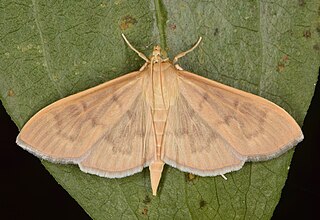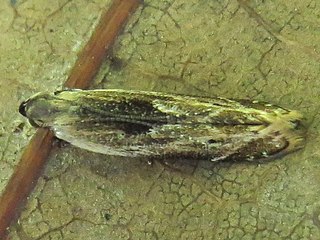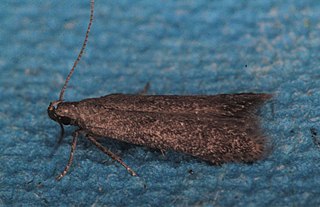
Monochroa is a genus of moths in the family Gelechiidae.

Hemonia is a genus of moths in the family Erebidae first described by Francis Walker in 1863. They are found only in Sri Lanka and Borneo.

Thumatha is a genus of moths in the family Erebidae. The genus was erected by Francis Walker in 1866. Species are distributed in the Oriental and Australian regions.

Timandra amaturaria, the cross-lined wave moth or cobra inchworm, is a species of moth of the family Geometridae. The species was first described by Francis Walker in 1866. It is found in the US from Massachusetts to Florida, west to Texas and north to Wisconsin.

Xyloryctidae is a family of moths contained within the superfamily Gelechioidea described by Edward Meyrick in 1890. Most genera are found in the Indo-Australian region. While many of these moths are tiny, some members of the family grow to a wingspan of up to 66 mm, making them giants among the micromoths.

Monochroa rumicetella is a moth of the family Gelechiidae. It was described by O. Hofmann in 1868. It is found from Fennoscandia and Belarus to Portugal, the Alps and Greece, and from France to Romania.
Ostrinia marginalis is a moth in the family Crambidae. It was described by Francis Walker in 1866. It is found in North America, where it has been recorded from Newfoundland and Maine west to Alberta, the Northwest Territories and Yukon. The habitat consists of bogs and marshes.
Ostrinia obumbratalis, the smartweed borer, is a moth in the family Crambidae. It was described by Julius Lederer in 1863. It is found in North America, where it has been recorded from New Brunswick and Manitoba to Louisiana and Florida.

Patania silicalis, commonly known as the herbivorous pleuroptya moth, is a species of moth in the subfamily Spilomelinae of the family Crambidae. It was described by Achille Guenée in 1854. It is found in Brazil, Venezuela, Ecuador, French Guiana, Guyana, Guatemala, Costa Rica, Panama, Mexico, Cuba, Jamaica, Puerto Rico, Hispaniola and the United States, where it has been recorded from Missouri, Michigan, Ohio and New York, south to Florida.
Monochroa disconotella is a moth of the family Gelechiidae. It was described by Vactor Tousey Chambers in 1878. It is found in North America, where it has been recorded from Kentucky, Maine, New Hampshire and Ohio.
Monochroa discriminata is a moth of the family Gelechiidae. It was described by Edward Meyrick in 1923. It is found in North America, where it has been recorded from southern Ontario.
Monochroa fragariae, the strawberry crown miner moth, is a moth of the family Gelechiidae. It was described by August Busck in 1919. It is found in North America, where it has been recorded from Oregon and British Columbia.

Monochroa gilvolinella is a moth of the family Gelechiidae. It was described by James Brackenridge Clemens in 1863. It is found in North America, where it has been recorded from Illinois, Indiana, Mississippi, New Hampshire and Pennsylvania.
Monochroa harrisonella is a moth of the family Gelechiidae. It was described by August Busck in 1904. It is found in North America, where it has been recorded from California, Washington, British Columbia and Florida.

Monochroa hornigi, the knotweed neb, is a moth of the family Gelechiidae. It was described by Otto Staudinger in 1883. It is found in most of Europe, European Russia, western and south-eastern Siberia, Transbaikalia, Korea and Japan (Hokkaido).
Monochroa japonica is a moth of the family Gelechiidae. It was described by Sakamaki in 1996. It is found in Japan and Korea.
Monochroa monactis is a moth of the family Gelechiidae. It was described by Edward Meyrick in 1923. It is found in North America, where it has been recorded from southern Ontario and North Carolina.
Monochroa perterrita is a moth of the family Gelechiidae. It was described by Edward Meyrick in 1923. It is found in North America, where it has been recorded from southern Ontario.
Monochroa pullusella is a moth of the family Gelechiidae. It was described by Vactor Tousey Chambers in 1874. It is found in North America, where it has been recorded from Illinois, Maine, New Hampshire, New Jersey, Oklahoma and Texas.
Monochroa robusta is a moth of the family Gelechiidae. It was described by Annette Frances Braun in 1921. It is found in North America, where it has been recorded from Ohio and South Carolina.







